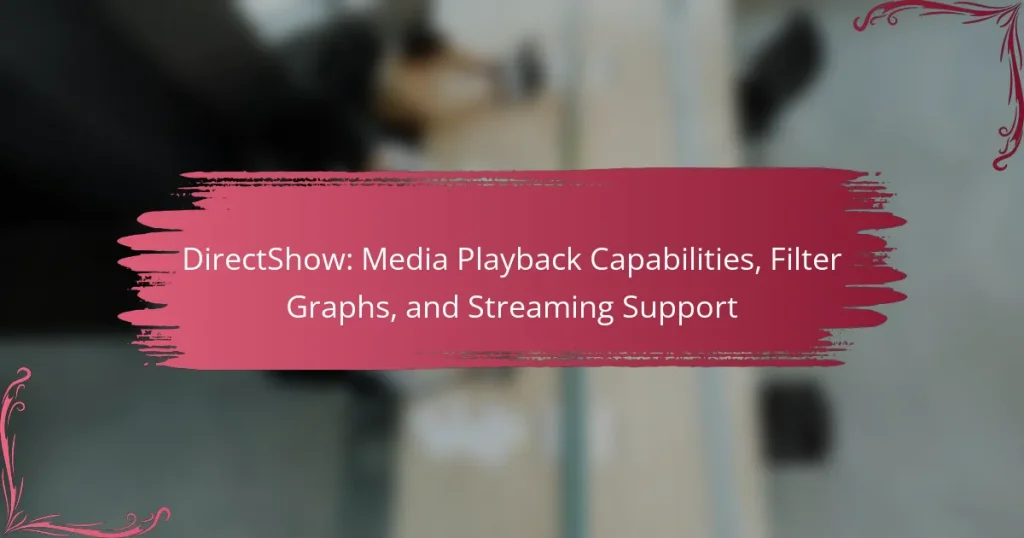DirectShow is a multimedia framework and API developed by Microsoft, designed for the playback and recording of audio and video content. It employs a filter graph architecture that allows developers to create applications capable of processing media streams through various filters for tasks such as decoding, rendering, and transforming media. The framework supports a wide range of media formats and codecs, facilitating flexible streaming capabilities for both live broadcasts and on-demand content. Additionally, DirectShow integrates with DirectX technologies, enhancing the performance and efficiency of multimedia applications. This article will explore the key features of DirectShow, including its filter graph structures, dynamic data flow management, and overall impact on media playback and streaming.

What is DirectShow?
DirectShow is a multimedia framework and API produced by Microsoft. It facilitates the playback and recording of audio and video content. DirectShow allows developers to create applications that can process media streams. It utilizes a filter graph architecture for media handling. Filters can be used for various tasks such as decoding, rendering, and transforming media. The framework supports numerous media formats and codecs. DirectShow is part of the Windows SDK and is widely used in media applications. Its capabilities include streaming support and real-time processing of multimedia data.
How does DirectShow facilitate media playback?
DirectShow facilitates media playback by using a modular architecture known as filter graphs. These filter graphs consist of various components called filters that handle different media processing tasks. Each filter in the graph performs a specific function, such as decoding, rendering, or processing audio and video streams.
DirectShow allows for the dynamic connection of these filters to create a playback pipeline tailored to specific media types. This flexibility supports a wide range of formats and codecs, enhancing compatibility.
Additionally, DirectShow manages data flow between filters, ensuring synchronized playback. It utilizes a scheduling mechanism to optimize performance and resource usage during playback. This architecture enables seamless streaming and playback of multimedia content across different applications and devices.
What are the key components of DirectShow?
The key components of DirectShow include filters, filter graphs, and media control interfaces. Filters are the building blocks of DirectShow. They handle specific tasks such as capturing, processing, and rendering media. Filter graphs are the connections between these filters. They define the flow of data through the filters. Media control interfaces manage the playback and control of media streams. These components work together to enable media playback capabilities and streaming support in DirectShow.
How do these components interact in media playback?
In media playback, components such as filters, filter graphs, and media sources interact to process and render audio and video data. Filters perform specific tasks like decoding, transforming, and rendering media streams. The filter graph organizes these filters in a sequence, defining the flow of data. Media sources provide the actual media content, which is fed into the filter graph.
The DirectShow architecture allows filters to communicate through pins, which are connection points for data transfer. Each filter has input and output pins that manage data flow. When a media source sends data, it travels through the filter graph, passing through various filters that modify or render the content.
This interaction is crucial for seamless playback. For instance, a video decoder filter receives compressed video data from the media source, decodes it, and sends the uncompressed frames to a renderer filter. This process ensures that the user experiences smooth and synchronized audio-visual playback.
The effectiveness of this interaction is supported by the modular design of DirectShow, which allows for the integration of different filters to accommodate various media formats.
What are the primary capabilities of DirectShow?
DirectShow provides several primary capabilities for media playback and processing. It supports the creation and management of filter graphs. Filter graphs allow for the processing of multimedia data through various components. DirectShow enables playback of audio and video formats. It also supports streaming from various sources, including files and network streams. Additionally, DirectShow facilitates real-time media capture from devices like cameras and microphones. The architecture allows for the integration of custom filters. This flexibility makes it suitable for diverse multimedia applications.
How does DirectShow handle different media formats?
DirectShow handles different media formats through a modular architecture of filters. Each filter is designed to process specific media types, such as audio or video. DirectShow uses filter graphs to connect these filters in a sequence. This allows for the flexible combination of various media formats. Filters can decode, render, or transform media streams.
DirectShow supports a wide range of formats, including AVI, MPEG, and WMV. It utilizes codecs to encode and decode these formats efficiently. The DirectShow framework manages the communication between filters and ensures proper data flow. This adaptability enables developers to create applications that work with diverse media types.
What features enhance the playback experience in DirectShow?
DirectShow enhances the playback experience through features like filter graphs, media control, and support for various formats. Filter graphs allow dynamic processing of media streams. This enables custom playback configurations tailored to specific needs. Media control features provide functionalities like play, pause, and seek. DirectShow supports a wide range of audio and video codecs. This versatility ensures compatibility with numerous media types. Additionally, it allows for real-time streaming and playback. These features collectively improve user experience and media interaction.

What are Filter Graphs in DirectShow?
Filter graphs in DirectShow are structures that define the flow of data between filters in multimedia applications. Each filter processes media data and connects to other filters to create a pipeline. This pipeline allows for operations like decoding, rendering, and processing audio and video streams. Filters can be added or removed dynamically, enabling flexible media handling. The graph is managed by a graph manager, which coordinates the execution of filters. Filter graphs are essential for building complex media playback and streaming applications. They support various media formats and codecs, enhancing compatibility across different systems.
How do Filter Graphs function within DirectShow?
Filter graphs in DirectShow serve as a framework for processing multimedia data. They consist of interconnected filters that handle tasks such as capturing, processing, and rendering media streams. Each filter performs a specific function, like decoding video or audio. The graph is built by connecting these filters in a logical sequence. Data flows through the graph from source filters to renderer filters. DirectShow manages this flow, ensuring that data is processed in the correct order. The graph can be dynamically modified, allowing for flexible media playback scenarios. This architecture supports various media formats and streaming protocols, enhancing playback capabilities.
What are the types of filters used in Filter Graphs?
The types of filters used in Filter Graphs include source filters, transform filters, and renderer filters. Source filters are responsible for retrieving data from media files or devices. Transform filters process the data, such as decoding or encoding audio and video streams. Renderer filters display or output the processed data to the user. Each filter type plays a crucial role in the overall media playback pipeline within DirectShow. This structure ensures efficient handling and processing of multimedia content.
How do filters process media data in the graph?
Filters process media data in the graph by manipulating data streams as they pass through. Each filter performs a specific function, such as decoding, rendering, or transforming the data. The filter graph organizes these filters in a sequence, allowing data to flow from one filter to another. As data enters a filter, it is processed according to the filter’s designated task. For example, a decoder filter converts compressed video into an uncompressed format. Filters can also apply effects or perform data analysis. The output from one filter becomes the input for the next in the graph. This structured approach enables efficient media playback and streaming.
What is the significance of Filter Graphs in media processing?
Filter graphs are crucial in media processing as they define the flow of data between different media processing components. They consist of interconnected filters that perform specific tasks such as decoding, rendering, or processing media streams. Each filter in the graph takes input, processes it, and passes the output to the next filter. This modular approach allows for flexibility and reusability of components.
Furthermore, filter graphs enable real-time processing of audio and video streams, facilitating efficient playback and streaming. They support various media formats and codecs, making them adaptable to different media types. The significance of filter graphs is evident in their ability to optimize performance and resource management during media playback.
How do Filter Graphs affect playback quality?
Filter graphs directly influence playback quality by managing the flow of media data. They consist of interconnected filters that process audio and video streams. Each filter can enhance, decode, or modify the media content. The arrangement and configuration of these filters determine the efficiency of data processing. Properly designed filter graphs can reduce latency and improve synchronization. Conversely, poorly configured graphs may lead to buffering or degraded video quality. Studies show that optimized filter graphs can enhance playback performance significantly. For example, using hardware-accelerated filters can offload processing from the CPU, resulting in smoother playback.
What challenges can arise when configuring Filter Graphs?
Challenges in configuring Filter Graphs include compatibility issues between filters. Filters must support the same media types to function correctly. Misconfiguration can lead to playback errors or crashes. Performance bottlenecks may arise if filters are not optimized. Debugging can be complex due to the interdependent nature of filters. Additionally, managing filter properties and settings requires in-depth knowledge of DirectShow architecture. Resource management is crucial, as improper handling can lead to memory leaks. Understanding these challenges is vital for successful media playback setup.

How does DirectShow support streaming?
DirectShow supports streaming by utilizing filter graphs to manage data flow. These filter graphs consist of various components that process media streams. Sources, such as network protocols, provide the media data. Filters manipulate this data, enabling tasks like decoding and rendering. The system supports multiple streaming formats, including live broadcasts and on-demand content. DirectShow’s architecture allows for dynamic connection and configuration of filters during runtime. This flexibility enhances the ability to stream diverse media types seamlessly. Moreover, DirectShow integrates with DirectX technologies, improving performance and efficiency in media playback.
What streaming protocols are compatible with DirectShow?
DirectShow is compatible with several streaming protocols. These include Real-Time Streaming Protocol (RTSP), Real-Time Transport Protocol (RTP), and Microsoft Media Server (MMS). Additionally, DirectShow supports HTTP streaming and Streaming Audio Video Protocol (SAP). These protocols enable effective media playback and streaming capabilities within DirectShow. The compatibility with these protocols is essential for multimedia applications and services.
How does DirectShow manage live streaming?
DirectShow manages live streaming through a series of filters that process audio and video data. It utilizes a filter graph to route and manipulate media streams. The source filter captures live data from devices or network streams. Subsequent filters can encode, decode, or transform the media. The final output filter renders the media to the display or sends it over the network. This modular architecture allows for flexibility and real-time processing. DirectShow supports various protocols and formats, enhancing its streaming capabilities across different platforms.
What are the benefits of using DirectShow for streaming applications?
DirectShow provides several benefits for streaming applications. It offers a flexible architecture for media playback. Developers can create custom filter graphs tailored to specific streaming needs. DirectShow supports a wide range of media formats, enhancing compatibility. It also allows real-time processing of audio and video streams. This capability is crucial for live streaming applications. Additionally, DirectShow integrates well with Windows operating systems, ensuring stability. Its support for DirectX technologies improves performance in multimedia applications. These features make DirectShow an effective choice for developers in the streaming domain.
What are some common use cases for DirectShow in streaming?
DirectShow is commonly used for various streaming applications. It facilitates the capture and playback of multimedia content. One use case is live video streaming, where DirectShow processes real-time video feeds. Another use case is video conferencing, enabling smooth communication through video and audio streams. DirectShow also supports streaming media over networks, allowing for efficient content delivery. Additionally, it is utilized in video editing applications, where users can preview and manipulate video streams. These use cases highlight DirectShow’s versatility in handling multimedia streaming tasks.
How is DirectShow utilized in video conferencing solutions?
DirectShow is utilized in video conferencing solutions to manage and process multimedia streams. It provides a framework for capturing, processing, and rendering audio and video data in real-time. DirectShow enables the integration of various media sources, such as webcams and microphones, into conferencing applications.
The filter graph architecture allows developers to create custom processing chains for video and audio streams. This flexibility supports various codecs and formats, ensuring compatibility with different devices. DirectShow also facilitates synchronization between audio and video, enhancing the quality of the conferencing experience.
Moreover, it supports network streaming protocols, enabling real-time transmission of media over the internet. This capability is crucial for effective video conferencing, as it allows seamless communication between participants. Overall, DirectShow’s robust features make it a vital component in developing efficient video conferencing solutions.
What role does DirectShow play in media broadcasting?
DirectShow plays a vital role in media broadcasting by facilitating the processing and streaming of audio and video content. It serves as a framework for building multimedia applications on Windows. DirectShow allows developers to create filter graphs that manage the flow of media data. These filter graphs consist of various components, such as source filters, transform filters, and renderer filters. Each filter performs specific tasks, like decoding or rendering media. DirectShow supports multiple media formats, enhancing compatibility in broadcasting scenarios. Additionally, it provides real-time streaming capabilities, essential for live broadcasts. The architecture of DirectShow allows for flexible media manipulation and integration with other technologies.
What best practices should be followed when using DirectShow?
Use proper error handling when implementing DirectShow. This ensures that any issues during media playback or processing are managed effectively. Initialize components in the correct order to avoid runtime errors. Utilize the appropriate media types for filters to ensure compatibility. Always release resources properly to prevent memory leaks. Implement threading correctly to enhance performance and responsiveness. Optimize filter graphs for efficiency by minimizing unnecessary filters. Test across different media formats to ensure robustness and stability.
DirectShow is a multimedia framework and API developed by Microsoft, designed to facilitate audio and video playback and recording. The article provides an in-depth exploration of DirectShow’s architecture, including its filter graph system that allows for flexible media handling and processing. Key components such as filters, filter graphs, and media control interfaces are discussed, highlighting their roles in managing data flow and enhancing playback quality. The article also covers DirectShow’s capabilities in supporting various media formats and streaming protocols, making it a versatile choice for multimedia applications, including video conferencing and live streaming. Best practices for implementing DirectShow effectively are also outlined to ensure optimal performance.


